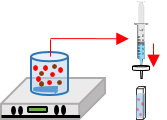UV-Vis spectroscopy
Ultraviolet-visible (UV-Vis) spectroscopy is a measurement technique that refers to the absorption of light in the UV-visible wavelength range of the substance in question. The UV region falls between 190-380 nm and the visible region lies between 380-750 nm. Each substance contains electrons that are capable of absorbing light of various wavelengths. The observed pattern of each substance is unique and thus detectable by the single absorbance peak (or range) at given wavelengths.
The machine used in NanoFASE is a diode array spectrophotometer (Agilent HP8453) which is capable of detecting all of the required wavelengths simultaneously. Other machines that have one single wavelength detector may require pre-setting to the desired wavelengths.
 |
|
Used in

Batch tests
Read more |
Read also |
|
OECD (2017) OECD Guidelines for the Testing of Chemicals, Section 3. Test No. 101: UV-VIS Absorption Spectra Columns. http://dx.doi.org/10.1787/9789264069503-en |
Contact

Jessica Adams
Centre for Ecology and Hydrology (CEH)
Email: jesams@ceh.ac.uk
